SCERT AP 7th Class English Government Textbook Answers 5th Lesson The Art of Weaving Textbook Questions and Answers.
AP State Syllabus 7th Class English Unit 5 Questions and Answers The Art of Weaving
7th Class English Unit 5 The Art of Weaving Textbook Questions and Answers
Look at the following picture and answer the questions that follow.
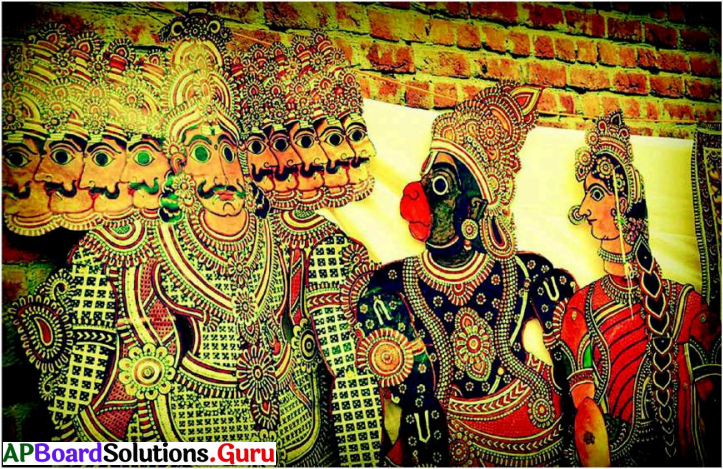
Question 1.
Have you seen any of these in your locality/place?
Answer:
Yes, I have seen this kind puppets in my primary school.
Question 2.
How do they make these puppets?
Answer:
They make these puppets with sticks, ropes, paper, cardboards, etc.
Question 3.
Have you ever tried any craft?
Answer:
No, I have never tried any craft.
Question 4.
Are there any craftsmen/craftswomen in your village/area?
Answer:
Yes, there are some craftsmen in our village. There are people who work on Embroidery, Knitting, Lace-making, Woodcraft, Pottery, Jewellery, etc.
![]()
Question 5.
What art/craft do you like the most?
Answer:
I like woodcraft and pottery most.
Reading Comprehension
A. Answer the following questions.
Question 1.
What is the specialty of a Mangalagiri saree?
Answer:
The Nizam design is a unique characteristic feature of Mangalagiri saree. The uniqueness of Mangalgiri cotton is because of its durability. The body and the pallu is embellished with zari or golden thread work with a Nizam border and geometrical and simple designs.
Question 2.
Explain what the warp and the weft are.
Answer:
The warp is the vertical thread and the weft is the horizontal thread.
Question 3.
Why do the weavers perform street-sizing?
Answer:
Street-sizing is the extension of the warp, spraying of starch and brushing followed by drying to get the fabric ready.
Question 4.
What problems do the weavers of Mangalagiri face?
Answer:
The weavers face many problems in the textile industry. They face tough competition, change in fashion, trends, scarcity of raw material and the involvement of middle men.
Question 5.
Are the handloom fabrics expensive? Why?
Answer:
Weaving fabric on a hand loom is more expensive than that of a power loom because the fabric is woven manually.
![]()
B. Arrange the following sentences in sequential order and write them in the space provided.
1) The yarn is kept in the sunlight for drying.
2) The street sizing process is done to make the thread thick and strong.
3) The yarn is boiled and sent for dyeing.
4) The yarn is rolled on an iron rod and fixed on a loom to weave.
5) The yarn bundles are placed on spinning wheel.
Answer:
3) The yarn is boiled and sent for dyeing.
5) The yarn bundles are placed on spinning wheel.
2) The street sizing process is done to make the thread thick and strong.
1) The yarn is kept in the sunlight for. drying.
4) The yarn is rolled on an iron rod and fixed on a loom to weave.
C. Read the following statements and say whether they are true or false.
1) Power lev ms are more expensive than handlooms. [ ]
2) Warp and weft is an interlacing method of weaving. [ ]
3) Warp refers to horizontal threads on woven cloth. [ ]
4) Nizam border is a unique feature of Mangalagiri saree. [ ]
5) Mangalagiri is a small town in Vijayawada district. [ ]
Answer:
- False
- True
- False
- True
- False
Correct the false statements and write them here :
1) ……………………………………….
2) ……………………………………….
3) ……………………………………….
4) ……………………………………….
5) ……………………………………….
Correct the false statements and write them here:
1) Handlooms are more expensive than power looms.
3) Warp refers to vertical threads on woven cloth.
5) Mangalagiri is a small town in Guntur district.
Vocabulary
A. Match the following words denoting their profession or trade.
| 1. A person who makes pots | a. tinker |
| 2. A person who weaves fabric | b. sculptor |
| 3. A person who goes from place to place to mend pots, pans, etc. | c. florist |
| 4. A person who makes furniture | d. potter |
| 5. A person who carves stones into idols | e. carpenter |
| 6. A person who sells flowers | f. weaver |
Answer:
| 1. A person who makes pots | d. potter |
| 2. A person who weaves fabric | f. weaver |
| 3. A person who goes from place to place to mend pots, pans, etc. | a. tinker |
| 4. A person who makes furniture | e. carpenter |
| 5. A person who carves stones into idols | b. sculptor |
| 6. A person who sells flowers | c. florist |
![]()
B. Read the following:
Today I helped my mom in the kitchen. I carefully cut the vegetables and my mom slowly placed them into a boiling pot of water. Next, mom quickly browned the onions while I patiently peeled off the potatoes. Immediately, my mom deeply fried the potatoes also. 1 eagerly waited for my nqxt job, which was to gently sprinkle spices into the vegetable soup. But I accidentally poured too much cumin. I quietly told my mom my mistake, and she sweetly told me that, initially, we made such mistakes. Gradually, you would be out of confusion.
In the above event, there are many words ending in ly. They are adverbs. They are formed by adding ‘ly’ to adjectives.
Adjective + ly = Adverb
E.g : approximate + ly
Identify the adverbs from the paragraph given above and write them in the space given.

Answer:

Look at the following image and make adverbs by adding ‘ly’. One is done for you.

Answer:
- happily
- angrily
- greatly
- quickly
- broadly
- cleanly
- beautifully
- colourlessly
C. Let’s learn some idioms to express ‘happiness’.

Use these idiomatic expressions in your own sentences. One is done for you.
E.g. I have been over the moon when I got gold medal in the National Athletics.
1. ……………………………………….
2. ……………………………………….
3. ……………………………………….
4. ……………………………………….
5. ……………………………………….
Answer:
1. walking on air:
Answer:
After the delivery of her baby, she was walking on air.
2. happy camper:
Answer:
There are no happy campers after the COVID-19.
3. jump for joy:
Answer:
We exactly jump for joy after our results.
4. have stars in your eyes:
Answer:
When she left the school, she had stars in her eyes.
5. on top of the world:
Answer:
She felt on top of the world when she was elected in the elections.
Grammar
A. Read the following sentences from the text:
One of us enquired, “Sir, what are you doing?”
He replied, “I am weaving a saree on the loom.”
Observe the verb in the sentence. It is in present progressive tense. It denotes the ‘on going’ actions.
Present Continuous tense / Progressive tense :
When Mary visits Kavya’s home to play, Kavya, her brother Naveen, and her neighbour Bibi are working in the garden.
Read the conversation among them.
Mary : Hello! Friends, what are you doing here?
Kavya : I’m digging a pit, Mary.
Naveen : I’m clearing the clay from the pit.
Mary : What are you plucking Bibi ?
Bibi : I’m plucking weeds in the garden.
Mary : Why are you digging the pit?
Kavya : We are planning to grow a rose plant here.
Mary : You are doing a very good job. Keep it up.
You might have noticed the use of present progressive tense in the above conversation.
Look!, Hear!, See!, Watch!, Listen!, etc. are generally used in present continuous tense.
Ex : Look ! I’m drawing.
See ! how the peacock is dancing.
Listen! I’m talking to you.
1. Frame as many sentences as you can from the following table.

a) …………………………………………..
b) …………………………………………..
c) …………………………………………..
d) …………………………………………..
e) …………………………………………..
Answer:
- I am making sweets for me.
- We are writing English homework.
- You are not writing English homework.
- He is folding cloth on handloom.
- She is not weaving sarees in the room.
- She is not cutting sweets for me.
- They are boiling water in the pot.
- I am not boiling water in the pot.
- We are not folding cloth on the handloom.
- He is not cutting sweets for me.
- She is not making sweets for me.
- They are writing English homework.
- You are boiling water in the pot.
- I am not weaving sarees in the room.
- We are not making sweets for me.
![]()
2. Write meaningful sentences using present continuous tense with the sets of words given.
a) butterflies- fly- garden ……………………………………………………
b) dogs – run – street ……………………………………………………
c) baby – crawl- floor ……………………………………………………
d) boy – dance – stage ……………………………………………………
e) girl – paint – picture ……………………………………………………
Answer:
a) Butterflies are flying in the garden,
b) Dogs are running in the street,
c) A baby is crawling on the floor,
d) A boy is dancing on the stage.
e) A girl is painting a picture.
B. Reported Speech
Look at the following sentences from the lesson.
1. Ramaiah, a weaver, greeted with a smile and replied, “We are street-sizing.”
2. He replied, “I am weaving a saree on the loom. ”
The part of the sentence that is kept within the inverted commas is the sentence actually spoken by the speaker. So, the above sentences are said to be in Direct Speech.
When the same sentences are told by someone other than the speaker they are said to be in Indirect speech (Reported Speech).
e.g. 1. Ramaiah, a weaver, greeted with a smile and replied that they were street-sizing.
2. He replied that he was weaving a saree on the loom.
Let’s observe the underlined words in the above sentences.
“that” is used as conjunction.
‘are’ in the sentence (1) has become ‘were’ and ‘am weaving’ in the sentence (2) has become ‘was weaving’.
Pronoun ‘we’ in the sentence (1) has become ‘they’.
‘I’ in the sentence (2) has become ‘he’.
Now, read the following conversation and complete the passage that follows.
The weaver :
Along with 5 persons, I have to work in each stage to weave a saree.
The students :
We are very happy to learn from you.
The weaver told the students ________ along with 5 to 6 persons ________ had to work in each stage to weave a saree and the students replied him _____, ____ were verv hannV to learn from him.
Answer:
The weaver told the students that along with 5 to 6 persons he had to work in each stage to weave a saree and the students replied him that they were very happy to learn from him.
C. Observe the position of the objects/things in the given picture.

Now, Read the following sentences. Tick (✓) the suitable preposition.
1. The fridge is in between/among the door and the clock.
2. The clock is before / on the wall.
3. The car is before/under the table.
4. The chair is placed against/before the table.
5. The books are on / in the shelf.
Answer:
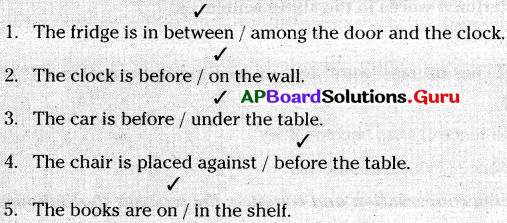
Writing
Go through the following invitation card.

Now, prepare an invitation card for a handicraft exhibition cum sale.
(Items of display: handloom fabrics, mats, designing pots, clay dolls, wall hangings etc., – 29-7-2021 -10.00 am to 5.30 p.m. – free entry- District Handloom Cooperative Society-by Homage to Heritage Association, Andhra Pradesh)

Talking Time
1. Role-play:
Jaya : Hallo! What are you doing?
Riya : I’m getting ready for the party.
Jaya : Oh! Really, How are you going there? .
Riya : Hmmm! We are going there by car.
Jaya : I see. Are your children coming?
Riya : Yes. They are coming.
Jaya : I am also planning to bring my children.
Riya : Oh! Very nice. Meet you there. Bye.
Language Function :
Here is a conversation between two friends in the classroom.
Raheem : Good morning, Shyam! Are you searching for something?
Shyam : You are right. I am searching for my English notebook.
Raheem : You gave it to our English teacher yesterday, didn’t you?
Shyam : Oh, My goodness! You have also given your notes, haven’t you?
Raheem : Yes, Bobby has given my notes to the teacher, hasn’t he??
Shyam : Okay. We shall collect them from our teacher, shan’t we?
In the above conversation ‘didn’t you’, ‘haven’t you’, ‘hasn’t he’, ‘shan’t we’ are tag questions. Tag questions are used to get confirmation.
Eg: Monika is a good girl, isn’t she?
![]()
I. Fill in the blanks with suitable question tag given in the box.
1. You like chocolates, _________ ?
2. She is amazing, _________ ?
3. You can’t sing, _________ ?
4. You are my best friend, _________ ?
5. I’m a good boy, _________ ?
6. They are reading books, _________ ?
7. My father doesn’t cook well, _________ ?
8. He wasn’t listening, _________ ?

Answer:
- You like chocolates, don’t you?
- She is amazing, isn’t she?
- You can’t sing, can you?
- You are my best friend, aren’t you?
- I’m a good boy, aren’t I?
- They are reading books, aren’t they?
- My father doesn’t cook well, does he?
- He wasn’t listening, was he?
Read the words aloud :
Identify the silent letters in the following words while your teacher is reading them aloud.
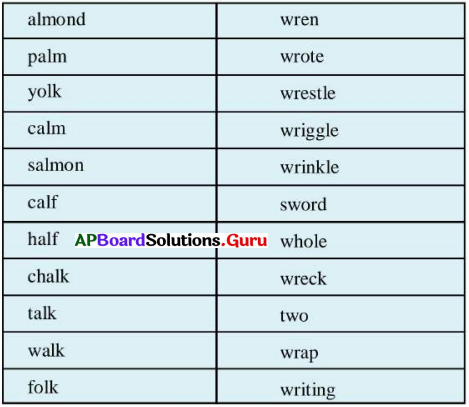
Answer:

Study Skill
Read the bar diagram carefully and answer the following questions.
HANDICRAFTS EXPORT
Source : Ministry of Textiles (Rs. in Crores)

1. What is the bar diagram about?
Answer:
The bar diagram is about Handicrafts Export.
2. What is the source of the information?
Answer:
Ministry of Textiles.
3. How many financial years are covered?
Answer:
Seven (7)
4. The export value was the highest in ( C )
A) 1990-91
B) 2000-01
C) 2002-03
Answer:
C) 2002-03
5. The observed trend for exports is ( A )
A) always increasing
B) always decreasing
C) neither increasing nor decreasing
Answer:
A) always increasing
Project
Design an advertisement for a cloth showroom.
Details to be included :
1. Name of the shop.
2. Items sold.
3. Address and contact information.
4. Tag line.
5. Sale offers (Discounts).
Answer:

Fun Time
Prepare a door-mat using old pieces of cloth, wool, fur, coir, etc. available in your surroundings.
Answer:
Doormat making from old clothes :
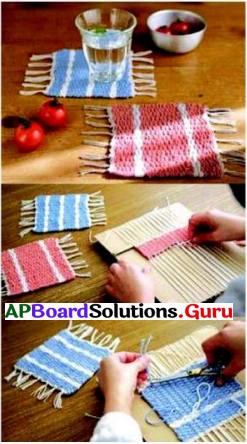
Step 1 :
First cut and open the Lungi. It will be about 6 ft long after cutting. The width is about 4 ft. Cut 3 inch wide strips from it. You can cut about 12 strips of 6 ft long each from this cloth.
Step 2 :
Take 3 strips in hand and tie them together at one end. Insert all three tied end of strips in the door or window grill.
Step 3 :
Tightly braid the three strips of cloth starting from the tied end. It is same as braiding hair. You can add another strip in the braid when the length of strip being braided reaches the end. After using all 12 strips you will have a 20 ft long braided length of cord.
Step 4 :
Trim the excess length of strip at end. Using the needle and thread, stitch the ends of all three strips in the braid together. Cut the ends tied with window grill and sew those ends also together.
Step 5 :
Start rolling from one end, roll the braided coil in circles to form the mat. Using a needle with dark coloured yarn, stitch the roll continuously with adjacent circle while rolling.
Step 6 : Continue to roll the coil as well. Continue stitching the rolled mat with the adjacent coil. Once you completed rolling of all 20 ft long coil, stitch the end with the mat and finish.
Now, the doormat is ready.
Language Game
Fill in the blanks with suitable spellings. One is done for you.
1. art (creative work, skill)
2. part (portion or piece)
3. chart (used for drawing a big picutre)
4. oxcart (a cart that is drawn by an ox)
5. restart (starting an engine again)
6. outsmart (beat through cleverness)
7. flowchart (process of diagram)
8. sweetheart (dearest to heart)
Listening
Listen to the following announcement made in an exhibition. Fill in the table given below.
Good evening to everybody. Warm welcome to all of you to this Sunday’s special programme. This is Vamsi welcomes you all to the Dum Dum Exhibition. This exhibition will be open from 4 p.m to 8 p.m. every day.
The visitors are requested to get their tickets from the counter. It is on the right to the Halloween corner. Each ticket costs Rs. 50/- and a family ticket is Rs. 200/-. There is a refreshment stall opposite to the ticket counter.
We have some special attractions : a motor cyclist in the well, a giant wheel, per-forming parrots, shooting galleries, many handicrafts and handloom fabrics. The show will run only for four more days. Request all your friends and relatives to visit this exhibition without fail.
Fill in the table as you listen.


Answer:
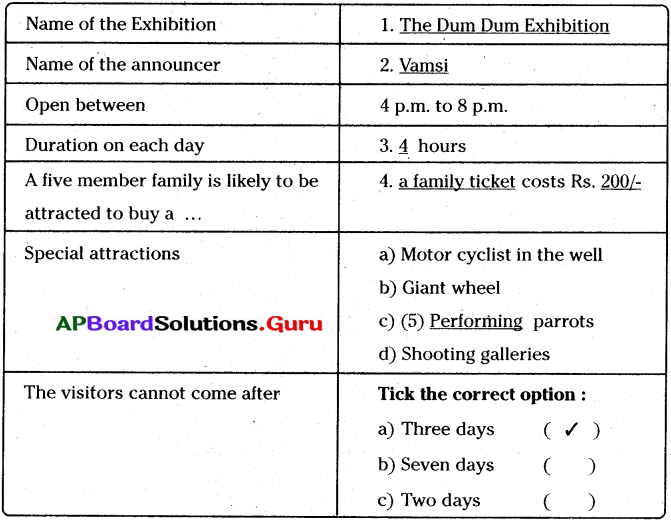
The Art of Weaving Summary
One day an English teacher took the class for a case-study to Mangalagiri, a famous town for handicraft weaving in Guntur District. The case-study is about weaving industry.
The students tried to know many things about the weaving industry in Manglagiri with the help of a master weaver named Veeraiah.
Mr. Veeraiah explained to them how they make the yarn suitable for dyeing. After dyeing it is washed, dried at room temperature and brought for the process of spinning. Later yarn spools are made ready for making a fabric.
A weaver named Ramaiah took the students and showed them an open area where the yarn was spread. Another weaver Sambayya explained to them that the uniqueness of Mangalagiri cotton is because of its durability. He said that they weave sarees, dress materials, kurtas, dupattas and shirts. It has a rich appearance. The quality of work done by the weavers and the pain the weavers take for weaving a saree keep the love for our Mangalagiri fabric.
Around 5000 weavers are working in the Mangalagiri textiles industry in a population of eighty thousand. Mangalagiri has a special place in the world textile map because of the handloom sarees and the dress-materials woven here are world famous.
The weavers face many problems in the textile industry. They face tough competition, change in fashion, trends, scarcity of raw material and the involvement of middle men. However the traditional value of handloom fabric is increasing for their uniqueness. Handloom fabric, thus, has a lot of global demand because of its artistic appeal.
Meanings For Difficult Worps
fabric (n.) : cloth or other material
occupation (n.) : a job or profession
migration (n.) : movement from one region to another
hank (n.) : coil or yarn bundle
warp (n.) : vertical thread
radiance (adj.) : glowing brightly or shining
extension (ta.) : stretching out
knotting (v.) : tying
enthusiasm (n.) : keen interest
evidently (adv.) : in a way that is seen or understood
durability (n.) : permanence
geometrical (adj.) : decorated with regular lines or shapes
distinguish (v.) : differentiate or identify
dobby (n.) : a mechanism attached to a loom for weaving small patterns
expensive (adj.) : costly
Indian Weavers Poem
WEAVERS, weaving at break of day,
Why do you weave a garment so gay?…
Blue as the wing of a halcyon wild,
We weave the robes of a new-born child,
Weavers, weaving at fall of night,
Why do you weave a garment so bright?
Like the plumes of a peacock, purple and green,
We weave the marriage- veils of a queen.
Weavers, weaving solemn and still,
What do you weave in the moonlight chill?
White as a feather and white as a cloud,
We weave a dead man’s funeral shroud. – Sarojini Naidu
Appreciation of the poem
I. Match the rhyming words and write them in the blanks given :
1. day – a. queen
2. wild – b. bright
3. night – c. gay
4. green – d. shroud
5. still – e. child
6. cloud – f. chill
Answer:
1. day – (c) gay
2. wild – (e) child
3. night – (b) bright
4. green – (a) queen
5. still – (f) chill
6. cloud – (d) shroud
![]()
II. Choose the correct answer:
1. What do the weavers weave in the early morning?
a) a bright blue cloth
b) a dull grey cloth
c) a soft white cloth
d) a red coloured cloth
Answer:
a) a bright blue cloth
2. The is purple and green coloured.
a) dress of the weaver
b) dress of the new born child
c) queen’s marriage veil
d) robe of the king
Answer:
c) queen’s marriage veil
3. What do the weavers weave in the chilly moonlight?
a) a garment light as feather
b) a garment meant to cover the dead man
c) a garment to keep away the chill
d) a garment to warp a new born child
Answer:
b) a garment meant to cover the dead man
4. The weavers weave at the fall of night.
a) funeral shroud
b) a garment so bright
c) robes of a new born child
d) a carpet
Answer:
b) a garment so bright
5. The bright garment is compared to
a) the stripes of a tiger
b) the wing of a parrot
c) the feathers of a peacock
d) the rainbow
Answer:
c) the feathers of a peacock
6. Whom does the poetess address in the poem?
a) the children
b) the queen
c) the weavers
d) all the above
Answer:
c) the weavers
III. Answer the following questions.
Question 1.
Why are the weavers solemn and still?
Answer:
The weavers are solemn and still because they are weaving a dead man’s funeral shroud.
Question 2.
What are the three events of life depicted in the poem?
Answer:
Birth, marriage and death are the three events referred to in this poem. These events indicate the three stages of human life – childhood, youth and old age.
Question 3.
Pick out the three types of cloth in the poem.
Answer:
The three types of cloths are (1) cloth for a new-born baby (2) cloth for the veils of a queen and (3) cloth to cover the dead body.
Question 4.
Why is white coloured cloth used for the funeral?
Answer:
The cloth is used to cover the dead body.
Question 5.
What colours do the weavers weave for the queen’s veil?
Answer:
The weavers weave purple and green colours for the queen’s veil.
![]()
Check Point
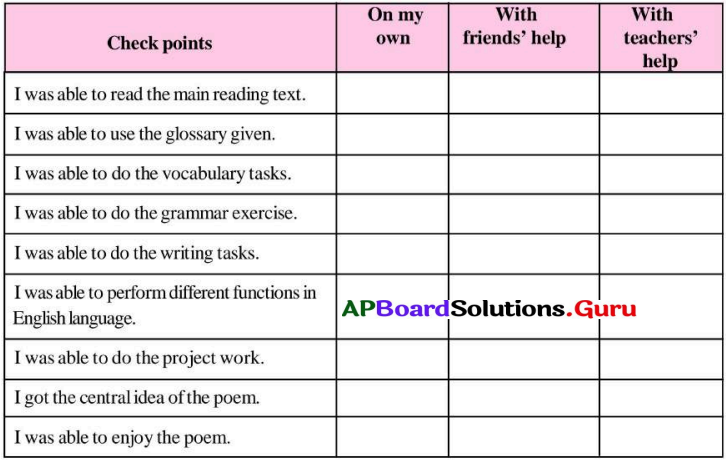
Indian Weavers Summary
Indian Weavers by Sarojini Naidu is a short poem consisting of three stanzas having four lines each.
The poetess talks about three types of dresses that the Indian Weavers weave at three particular times of the day. Metaphorically each time and the dress weaved in that time symbolizes a particular stage of life.
The poetess uses a number of literary devices to express her ideas like simile, metaphor, etc. The poem also consists of a discussion between the poet and the weavers; the poet asks the weavers and the latter reply.
STANZA 1 :
In the first stanza, the poetess questions the weavers that why are they weaving clothes early in the morning that seem to be quite beautiful and charming and of a particular colour. The poetess is curious to know about these clothes as they seem quite special. The weavers reply that the clothes that they are weaying are blue as the wing of a halcyon which is the other name of the kingfisher whose wings are bright blue in colour. The weavers reply that they are weaving the robes of a new-born child who has just come to the world. This stanza describes the first stage of human life which is full of freshness, happiness, beauty and hope and there is no place for sorrow at this stage.
STANZA 2 :
In this stanza, the poetess meets the Indian weavers again during the fall of night and asks why they are weaving a cloth late in the evening which is the time when most of the Indian marriages take place. She also asks why they are weaving a garment so bright like the plumes (feathers) of a peacock, purple and green. The weavers reply that the cloth is bright and richly coloured because they are weaving it for a queen. She will use it to make her marriage veil. This stanza describes the second or adult stage of life when humans quest for a better and prosperous life. The colours purple and green symbolize the ups and downs of the life that makes adulthood bright.
STANZA 3 :
In the final stanza, the poetess finds the weavers quite sorrowful, grieved and silent. They are weaving something weird in the dead of the night which is colourless and lifeless so, rather than asking why are they weav-ing, she asks what are they weaving? The weavers reply that they are weaving shroud which means a cloth used to put on the dead body. This represents the final stage of human life that is death which is lifeless and emotionless just like a white cloud or a feather. However, the white colour also symbolizes eternal peace and calm that comes with death.
The poem sums up human life in three main stages using symbols like clothes and times of the day. The life starts its journey with blue colour representing joy and hap-piness and then come green and purple that represent the ups and downs of life along with happiness and finally comes a single colour – white that represents the last stage of human life when the person dies and with him the emotions that were connected to life die as well.
![]()
Poectic Devices Used In The Lines
1. Weavers, weaving at break of day.
Alliteration – The sound of letter “w” is repeated- Weavers, weaving
Metaphor – The birth (childhood stage of man) is implicitly compared with a break of day.
2. Why do you weave a garment so gay? …
Alliteration – The sound of letter “g” is repeated- garment so gay
3. Blue as the wing of a halcyon wild.
Alliteration – The sound of letter “w” is repeated- wing of a halcyon wild
Simile – The blue coloured cloth is directly compared with a wing of wild halcyon.
4. We weave the robes of a new-born child.
Alliteration – The sound of letter “w” is repeated- We weave
5. Weavers, weaving at fall of night.
Alliteration – The sound of letter “w” is repeated- Weavers, weaving
Metaphor- Adulthood (young – the second stage of man) is implicitly compared with the fall of night.
6. Why do you weave a garment so bright?
Alliteration – The sound of letter “w” is repeated.
7. Like the plumes of a peacock, purple and green.
Simile – The garment is directly compared with purple and green coloured plumes of peacock.
Alliteration – The sound of letter “p” is repeated- plumes of a peacock, purple
8. We weave the marriage-veils of a queen.
Alliteration – The sotind of letter “w” is repeated- We weave
9. Weavers, weaving solemn and still.
Alliteration – The sounds of letters “w” and “s” are repeated- Weavers, weaving
10. What do you weave in the moonlight chill?
Alliteration – The sound of letter “w” is repeated.
Metaphor – death (old age – the third and last stage of man’s life) is implicitly compared with moonlight.
11. White as a feather and white as a cloud.
Simile – The garment is directly compared with a feather and a cloud.
12. We weave a dead man’s funeral shroud.
Alliteration – The sound of letter “w” is repeated.
13. White as a feather and as a cloud.
We weave a dead man’s funeral shroud.
Simile – funeral shroud is directly compared with a feather and a cloud.
Indian Weavers About the Poet
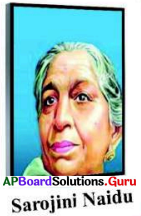
Sarojini Naidu, the Nightingale of India was born on 13th February 1879 in Hyderbad. She is an Indian Independence activist, politician, a renowned orator and accomplished poet. She was elected as the first President of the Indian National Congress. Sarojini Naidu as a poet belongs to an era of struggle, slavery and freedom fighting. The poem Indian Weavers, one of her poems, explains different stages of life.
Meanings For Difficult Words
weaver (n) : a person who weaves fabric
gay (adj) : (here) brightly coloured
halcyon (n) : a tropical Asian and African kingfisher with brightly coloured plumage
break of day (phr.) : early morning
garment (n) : a single item of clothing
robe (n) : a long loose outer garment
fall of night (phr.) : late in the evening
veil (n) : a piece of material owned by a woman to protect face
plume (n) : a long soft feather or arrangement of feathers
solemn (adj) : deeply serious
funeral (n) : a ceremony to honour a deceased person
still (adj) : quiet
shroud (n) : a cloth for the dead
